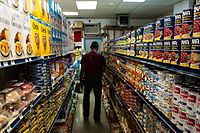
Photo from wikipedia
Abstract Greater London has a vibrant food scene comprising of many different types of urban and peri-urban ‘short food supply chains’ (SFSCs). This paper reports on exploratory research, which used… Click to show full abstract
Abstract Greater London has a vibrant food scene comprising of many different types of urban and peri-urban ‘short food supply chains’ (SFSCs). This paper reports on exploratory research, which used examples of SFSCs from London to build a more detailed understanding of different types of urban SFSC and their relative performance compared to each other. To do this, we undertook a participatory sustainability impact assessment (SIA) in which local food system stakeholders were asked to rank the perceived impacts of five different urban and peri-urban SFSCs compared with the current ‘mainstream’ food supply system (defined as supermarkets retailing mass-produced, standardized food products). The SFSCs ranked were: (1) urban gardening (self-supply), (2) urban gardening (commercial), (3) community supported agriculture (CSA), (4) direct sale (on-farm) and (5) direct sale (off-farm). Results from the SIA showed that CSAs were regarded as delivering the highest overall social, economic and environmental benefits, followed by urban gardening (commercial), urban gardening (self-supply) and direct sales (off-farm). The lowest overall rating was for the supply chain direct sales (on-farm). All five SFSCs were ranked highest on the social aspects of sustainability. Following the participatory SIA of perceived sustainability, we next developed a questionnaire in order to test the feasibility of measuring the specific (rather than ‘perceived’) impacts of an urban SFSC. We applied the test at a community-led local food market in South London, where we conducted face-to-face interviews with all market stallholders (18 respondents) and a random sample of consumers (51 respondents). Results from the community-led market were similar to those acquired at the SIA workshop, with greater agreement about the social benefits of the market, compared with economic and environmental impacts. The results also suggest that producers underestimated consumers’ willingness to share the risks that the producers face and we identify this as an important aspect for future research. The paper concludes with reflections on the strengths and weaknesses of the SIA methodology.
Journal Title: Renewable Agriculture and Food Systems
Year Published: 2017
Link to full text (if available)
Share on Social Media: Sign Up to like & get
recommendations!